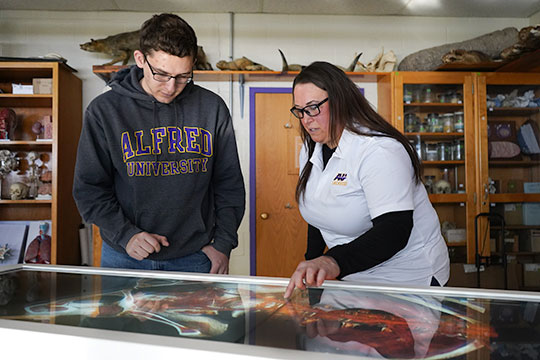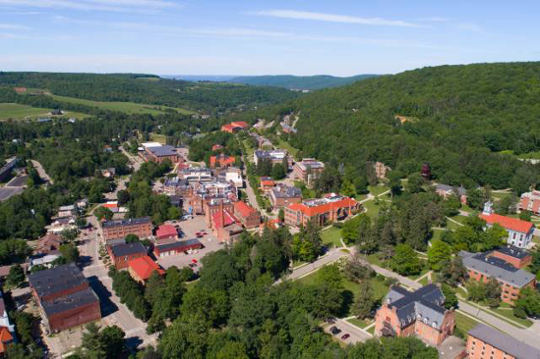
Biochemistry
With our major in Biochemistry, you will examine biological concepts with a strong foundation in basic chemical principles revealing the molecular basis for disease, evolution, organismal development, reproduction, agriculture and more. Built from the same foundation as our Biology programs, in Biochemistry you will dive deeper into biochemistry, organic chemistry, physical chemistry, physics and calculus.
Major
Minor
Biochemistry Major (124 credits)
Foundation and Core Courses (50 credits):
Take one of the following:
- BIOL 150 Biological Foundations - 4 credits
- BIOL 155 Biological Foundations: Research Project - 4 credits
Take one of the following:
- BIOL 212 Principles of Genetics - 4 credits
- BIOL 213 Structure & Function of Organisms - 4 credits
Take all of the courses below (42 credits):
- BIOL 211 Cell Biology - 4 credits
- BIOL 226 Biostatistics - 4 credits
- BCHM 390 Junior Seminar - 1 credit
- BCHM 420 Biochemistry: Proteins & Metabolism - 4 credits
- BCHM 422 Biochemistry: Nucleic Acids - 4 credits
- BCHM 490 Senior Seminar - 1 credit
- CHEM 105 General Chemistry 1 - 4 credits
- CHEM 106 General Chemistry 2 - 4 credits
- CHEM 315 Organic Chemistry 1 - 4 credits
- CHEM 316 Organic Chemistry 2 - 4 credits
- CHEM 321 Intro to Analytical Chemistry - 4 credits
- CHEM 343 Physical Chemistry 1 - Thermodynamics & Kinetics - 4 credits
Specialization (8 credits):
Take 8 credit hours from BIOL, BCHM, or CHEM courses at the 300 or 400 level in consultation with your advisor.
Related Courses (16 courses):
- Take all of the courses below:
- MATH 151 Calculus I - 4 credits
- MATH 152 Calculus II - 4 credits
- PHYS 111 Intro to General Physics I - 4 credits OR
- PHYS 125 Physics I - 4 credits
- PHYS 112 Intro to General Physics II - 4 credits OR
- PHYS 126 Physics II - 4 credits
College, University and Elective Requirements:
- College of Liberal Arts & Sciences General Education (40 credits)
- University Requirements (7 credits)
- Electives to meet college total of 124 total credits (3 credits)
Please see the Biology Three Year Plan included on the Biology webpage for course availability.
You will complete a core of courses and select a prescribed number of elective courses related to your personal and career interests. All courses taken as part of the Biochemistry major must be passed with a grade of C or better.
In addition to fulfilling the requirements of the major in Biochemistry, as well as the College of Liberal Arts & Sciences general education requirements, you'll be required to complete the College's First Year Experience Program or Transfer Student Program.
Study What You Love
Independent study projects in biology provide an opportunity for students to pose original questions of interest to them and formulate responses which may be research based, literature based, or the result of a creative endeavor. Students are encouraged to have fun with their projects and enjoy the opportunity for in-depth study in an area of their choosing.
Students develop and carry out their ideas with the advice and guidance of a faculty member and the final project is presented to the Division of Biology and Biochemistry in the form of a thesis, poster, oral presentation, or other acceptable format.
Course Credit
The independent study is taken as either BIO 450 (Independent Study) or BIO 485 (Internship in Biology), depending on the degree of independent work.
Funding
Students may apply for an Alfred Research Grant for Undergraduate Students (ARGUS) to help fund their projects. Faculty may have other sources of funding to support student work as well.
Selected Biology Student Independent Research Projects
- An investigation of prion protein interactions and other causal factors in the development and onset of Alzheimer’s Disease
- The effect of enrichment methods on cribbing in Equus caballus
- The influence of equine conformation on performance
- How to address Toxocara in humans and companion animals as a public health issue
- Assessment of intra- and inter- species interactions and use of space between captive common squirrel monkey, black capped squirrel monkey, howler monkey, and capuchin monkeys
- GMO’s effect on health and the environment
- Investigating the relationship between hair dye and hair tensile strength
- Gender markers in Nepenthes
- Molecular genetics of autofluorescence in Avena sativa
- Color vision in California sea lions (Zalophus californianus)
- Indications of Exhibit Quality based on Captive Felid Behaviors
- Territorial behavior and dominance hierarchies between three species of African cichlids
- Chemotaxis responses to pheromones in cockroaches
- Attempts to establish a cricket colony and future chemotactic studies
- Integrated human health: A review of the integration of complementary and alternative medicine with conventional healthcare
- Behavioral responses to novel objects in North American river otters (Lonta canadensis)
- Learning, imitation, and time-expenditure frequencies in Lontra canadensis
- Manufacturing cockroach pheromones and testing their effectiveness
- The effect of latitude on reproductive behavior and timing in the North American river otter (Lontra canadensis)
- Differences in seasonal reproduction patterns between tropical and temperate squirrel monkey (Saimiri sciureus) populations
- Research in equine nutrition: diet changes in PSSM horse
- Human impacts on extinction and threat of extinction of island avifauna
- Investigation of the presence of the phorid fly Apocephalis borealis and other causes of CCD in honeybee hives of Alfred NY
- Engineering Chimeras to Monitor Multiplex Interactions
- Genetics of Zebrafish
- Zinc finger nucleases: The past and present of in vivo genome editing
- The effects of cigarette smoke on plants
- Integrated human health: a review of the integration of complementary and alternative medicine with conventional medicine
- Microbial community analysis of a human versus a canine oral cavity
- Spore formation by the gram negative bacteria Chitinophaga pinensis
- Antimicrobial activity of silver containing cements
- The synthesis of small molecules to inhibit FabI in the fatty acid synthesis pathway of apicoplast parasites
- Interaction analysis of a putative MafA-like protein and a hypothetical protein with AniA, an anaerobically induced outer membrane protein of Neisseria gonorrhoeae
- Identification of nematode species found in the oat rhizosphere
- Identification of bacteria found in the rhizosphere of oats (Avena sativa)
- Phylogenetic analysis of microorganisms living in streams impacted by acid mine drainage
- Evaluation of microbial community structures and coliform persistence in the Alfred Wastewater Treatment Facility reed bed sludge treatment system
- Microbial community analysis of fungi in oat rhizosphere
- Nematode maintenance and culture
- Novel apparatus for growing and examining plant-microbe rhizosphere relationships
- Microbial degradation of petroleum hydrocarbons within various soil textures
- Biofilm Formation of Neisseria gonorrhoeae: A Sea of Unexplored Possibility
- The effects of minimal fluoride exposure on the uptake of nutrients in agricultural and horticultural plants
- Genetic diversity of American beech and Canadian hemlock in Allegany County
- The Therapeutic potential of Viral-Vector Based, Antigen Specific, Vaccines for Oral Cancer
- Tissue culture and cytogenetics of Amazon water lilies
- Steady State Nitric Oxide Levels in Neisseria gonorrhoeae
- Physiological analysis of Growth Patterns in Two Mutant Strains of Neisseria gonorrhoeae
- Tissue culture of insectivorous plants
- Anaerobic Liquid Culture of Neisseria gonorrhoeae
- An Investigation into the Sources of Fecal Coliforms in the Canacadea Creek
- The chemical basis of autofluorescence of oat hulls
- Analysis of the Role of the Highly Conserved Region in Bacterial Quinoprotein Dehydrogenase Based on Relative Kinetic Studies of Site-Directed Mutation in Escherichia coli
- Oil-degrading Microbes at AU
- Effect of Cranberry Extracts on Helicobacter pylori
- Statistical analysis of body piercings in AU students
- An Investigation of Extremophiles in Extraterrestrial Environments
- Sensitivity of Neisseria gonorrhoeae to Human Serum
The Division of Biology and Biochemistry rewards deserving students for their progress, performance, and dedication to the field. Eligible students may qualify for the following awards:
Brenda Bernstein Butner Award in Botany
The Brenda Bernstein Butner Award in Botany funds outstanding student research projects on native plants. This award provides a stipend for a semester-long or summer project.
University Advisory Committee for the Health Professions Scholarships
Each year three merit-based awards are given to one sophomore, one junior and one senior student interested in animal or human medicine and who, by their academic, extracurricular and health-related practical experiences, have demonstrated a strong motivation and potential for pursuing a career in a health profession.
Diana Mossip Memorial Scholarship
One of our most treasured scholarships is in memory of Diana Mossip who entered Alfred University in 1994 and was killed in a tragic automobile accident while still a student in 1996. Diana was a National Merit Scholar and a member of the Honors Program. She was majoring in Biology and had planned a career in veterinary medicine. Diana was a member of the Biology Club, assisted with blood drives, and enjoyed living in the Brick Residence Hall.
As an organ donor, Diana provided the gift of life to several people. Her family provides the gift of education by awarding the scholarship annually to two deserving students who are planning future careers in veterinary, human or dental medicine.
According to US News & World Report's Best Jobs, Biochemists have a median salary of $93,280.
What kind of job will I get with a Biochemistry degree?
- Forensic Scientist
- Medicinal Chemist
- Biotechnologist
- Analytical Chemist
- Biomedical Scientist
- Clinical Research Associate
- Clinical Biochemistry Scientist
- Academic Researcher
Where will I work?
- Medicine
- Dentistry
- Veterinary
- Food Science
- Agriculture
- Pharmacology
- Physiology
- Microbiology
- Toxicology
- Clinical Chemistry
Our Biochemistry program will also meet your needs if you plan to enroll in graduate school in the natural sciences.
News
Learn how Alfred University's Biology and Biochemistry programs are changing the landscape of learning through the latest classroom technologies, continuous faculty research and hands-on student engagement.

